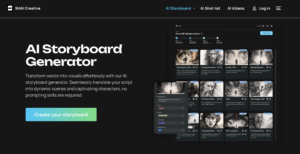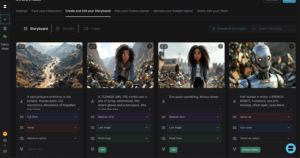Everything you need to know about OpenAI Sora in 2025 starts with understanding its revolutionary approach to video creation. OpenAI Sora transforms text prompts into cinematic videos, offering filmmakers and content creators an AI-powered alternative that, while impressive, lacks the precision of dedicated AI storyboard generators like Shai.
What is OpenAI Sora?
OpenAI Sora is a text-to-video generative AI model that converts written descriptions, images, and existing videos into dynamic visual content. Launched to ChatGPT subscribers in December 2024, Sora represents OpenAI’s entry into AI video generation, targeting content creators, filmmakers, and digital storytellers who want to explore new forms of visual storytelling through artificial intelligence.
What is OpenAI Sora Used For?
- AI Video Prototyping – Quickly visualize concepts before full production
- Social Media Content Creation – Generate eye-catching videos for platforms
- Educational Video Production – Transform lessons into engaging visual content
- Marketing Campaign Visualization – Create promotional videos from text briefs
- Experimental Filmmaking – Explore creative possibilities with AI-generated scenes
AI Video Prototyping with Sora
Everything you need to know about OpenAI Sora uses in 2025 begins with its prototyping capabilities. Filmmakers use Sora to quickly test visual concepts before committing resources to full production. The platform generates up to 20-second clips from text descriptions, allowing creators to experiment with different scenes, moods, and visual styles.
However, Sora’s approach differs significantly from traditional storyboarding. While it excels at creating dynamic video sequences, it lacks the frame-by-frame control that professional filmmakers require. The Storyboard feature attempts to address this by allowing users to specify inputs for different frames, but gaps between cards often result in unpredictable AI-generated content that may deviate from the original vision.
Marketing Campaign Visualization
Marketers leverage Sora to rapidly prototype advertising concepts and social media campaigns. The platform’s ability to generate multiple variations from a single prompt enables quick A/B testing of visual concepts. Advertisers can explore different stylistic approaches using preset filters like “moody film noir” or “cardboard and papercraft” to match brand aesthetics.
Despite these capabilities, Sora’s limitations become apparent in professional marketing workflows. The inability to maintain consistent character appearance across scenes poses challenges for brand mascots or spokesperson-driven campaigns. Additionally, the lack of precise shot control makes it difficult to align with specific creative briefs that require exact framing and composition.
Experimental Filmmaking and Creative Exploration
Artists and experimental filmmakers embrace Sora as a tool for pushing creative boundaries. The platform’s AI-driven approach often produces unexpected results that inspire new artistic directions. Features like Remix, Blend, and Loop enable creators to manipulate existing content in innovative ways, creating surreal or abstract visual experiences.
The experimental nature of Sora makes it particularly suitable for projects where unpredictability enhances creativity. Musicians use it for music video concepts, while digital artists incorporate Sora-generated content into larger multimedia installations. However, for narrative-driven projects requiring precise storytelling control, these same features can become limitations.
OpenAI Sora Features in 2025
- Sora Turbo Engine – Significantly faster video generation compared to the February 2024 preview
- Storyboard Timeline Editor – Sequence multiple prompts to create longer, connected videos
- Enhanced Resolution Options – Support for 480p, 720p, and 1080p output formats
- Community Feed Integration – Discover and remix videos created by other users
- C2PA Metadata Implementation – Built-in content authentication for transparency
How Much Does OpenAI Sora Cost?
OpenAI Sora operates on a credit-based system integrated with ChatGPT subscription tiers:
- ChatGPT Plus ($20/month): 1,000 credits monthly, 720p maximum resolution, 5-second video duration
- ChatGPT Pro ($200/month): 10,000 credits monthly, 1080p resolution, 20-second duration, priority processing
- ChatGPT Team: Custom pricing with team collaboration features
- Future Sora-Specific Plans: Dedicated pricing tiers expected in early 2025
OpenAI Sora Pricing Explained
Everything you need to know about OpenAI Sora pricing in 2025 revolves around its credit consumption model. Credits vary based on resolution and duration – a 5-second 480p video costs 20 credits, while a 20-second 1080p video requires 600 credits. Credits don’t roll over monthly, creating pressure to maximize usage within billing cycles.
The pricing structure favors short-form content creation. Pro users generating maximum-length 1080p videos can only create approximately 16 videos monthly before exhausting their credit allocation. This limitation makes Sora less cost-effective for production studios requiring extensive video generation compared to dedicated AI storyboard generators that offer unlimited storyboard creation.
Company Story
OpenAI introduced Sora as part of its mission to advance artificial general intelligence that benefits humanity. The project emerged from research into teaching AI to understand and simulate physical world dynamics. Initial development focused on creating a model that could maintain visual consistency while understanding complex spatial relationships and physics.
The February 2024 preview generated significant attention from the creative community, leading to extensive red-teaming with visual artists, filmmakers, and safety experts. This collaborative approach shaped Sora’s development, balancing creative freedom with safety measures to prevent misuse.
OpenAI’s decision to integrate Sora with ChatGPT subscriptions rather than launching a standalone product reflects their strategy of building an interconnected AI ecosystem. The platform represents OpenAI’s expansion beyond text and image generation into dynamic visual content, positioning them in competition with other emerging video AI platforms.
Why Use AI Storyboard Generator Software?

Shai’s intuitive interface where users can upload a script and generate visual storyboards, complete with scene sequencing, shot duration, and voiceover options — all in one platform.
AI storyboard generators revolutionize pre-production workflows by automating the visualization process. Traditional storyboarding requires artistic skills and significant time investment, often creating bottlenecks in production pipelines. AI-powered solutions democratize this process, enabling creators without drawing abilities to communicate visual ideas effectively.
Moreover, these tools enhance collaboration between creative teams. Directors can quickly iterate on shot compositions, while producers gain clearer project visualization for budget planning. The ability to generate multiple storyboard variations helps teams explore creative options before committing to expensive production decisions.
Furthermore, AI storyboard generators maintain consistency across projects. Character models, location details, and visual styles remain uniform throughout the storyboard, eliminating continuity concerns that plague manual processes. This consistency proves especially valuable for episodic content or franchise productions requiring visual coherence.
Additionally, modern AI storyboard tools integrate with existing production workflows. Export options for industry-standard formats ensure seamless handoffs to animation teams, cinematographers, and post-production specialists. This integration reduces friction in the creative process while maintaining professional standards.
Why Look for an Alternative?
- Limited storyboard functionality – Sora generates videos, not structured frame-by-frame storyboards
- No character consistency guarantee – Characters may appear different across scenes
- Lack of precise shot control – Cannot specify exact camera angles or framing
- Credit limitations restrict usage – Monthly caps prevent extensive project development
- Geographic restrictions – Unavailable in UK, EU, and Switzerland
- No professional export formats – Missing PDF storyboard exports for team distribution
- Unpredictable gap filling – AI adds unwanted content between storyboard frames
- Missing collaboration features – Limited team workflow and feedback tools
Lack of Professional Storyboard Structure
What you need to know about OpenAI Sora alternatives in 2025 starts with understanding its fundamental limitation: Sora creates videos, not storyboards. Professional filmmakers require panel-by-panel layouts showing specific shots, camera movements, and scene transitions. Sora’s video-first approach fails to provide the structured documentation teams need for production planning.
No Guaranteed Character Consistency
Character continuity remains Sora’s most significant weakness for narrative projects. The AI cannot maintain consistent character appearances across multiple scenes, making it unsuitable for story-driven content. This limitation forces creators to accept visual inconsistencies that would be unacceptable in professional productions.
Absence of Manual Shot Adjustments
Professional storyboarding demands precise control over every visual element. Sora’s AI-driven generation offers no manual override for adjusting camera angles, modifying character positions, or refining scene compositions after generation. This inflexibility prevents the iterative refinement process essential to professional pre-production.
Why Choose Shai?

Shai storyboard view showing AI-generated frames from uploaded script
Why look for an OpenAI Sora alternative – what you need to know in 2025 centers on Shai’s purpose-built approach to AI storyboarding. Unlike Sora’s video generation focus, Shai provides structured, professional storyboards with complete creative control. The platform ensures character consistency through advanced AI modeling, maintaining visual continuity across entire projects.
Shai addresses every limitation found in Sora’s approach. Users gain precise shot control with professional camera angle options, while the script-to-storyboard automation intelligently interprets screenplay formatting. Real-time adjustments allow filmmakers to refine compositions, modify character expressions, and perfect scene details without regenerating entire sequences.
The platform’s export flexibility sets it apart from video-only solutions. Shai generates industry-standard PDFs, image sequences, and presentation formats that integrate seamlessly with existing production workflows. Team collaboration features enable live feedback, version control, and multi-user editing sessions that Sora cannot match.
Most importantly, Shai’s unlimited project model eliminates credit anxiety. Filmmakers can iterate freely, exploring creative options without worrying about monthly limitations. This approach aligns with professional production needs where extensive revision and refinement are standard practice.
AI storyboard generators like Shai understand that pre-production requires documentation, not just visualization. The platform bridges the gap between creative vision and practical execution, providing tools that speak the language of professional filmmaking while leveraging AI’s efficiency advantages.
Conclusion
Everything you need to know about OpenAI Sora in 2025 reveals an impressive AI video generator with notable limitations for professional storyboarding. While Sora excels at creating dynamic video content from text prompts, its lack of structured storyboard features, character consistency, and precise shot control make it unsuitable for serious pre-production work.
For filmmakers, animators, and content creators seeking true AI-powered storyboarding, Shai Creative offers the professional features Sora lacks. With script-to-storyboard automation, guaranteed character consistency, and comprehensive export options, Shai transforms how creative teams approach pre-production planning.
Ready to experience the future of AI storyboarding? Sign up for Shai today and discover how professional AI storyboard generators can revolutionize your creative workflow.